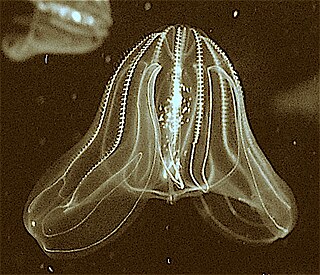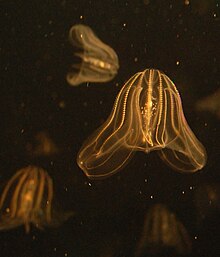
Ctenophora comprise a phylum of marine invertebrates, commonly known as comb jellies, that inhabit sea waters worldwide. They are notable for the groups of cilia they use for swimming, and they are the largest animals to swim with the help of cilia.

The Lamniformes are an order of sharks commonly known as mackerel sharks. It includes some of the most familiar species of sharks, such as the great white as well as less familiar ones, such as the goblin shark and megamouth shark.

Mnemiopsis leidyi, the warty comb jelly or sea walnut, is a species of tentaculate ctenophore. It is native to western Atlantic coastal waters, but has become established as an invasive species in European and western Asian regions. Three species have been named in the genus Mnemiopsis, but they are now believed to be different ecological forms of a single species M. leidyi by most zoologists.
Henry Bryant Bigelow was an American oceanographer and marine biologist.

Myliobatis is a genus of eagle rays in the family Myliobatidae.

Eumetula is a genus of minute sea snails, marine gastropod molluscs in the subfamily Eumetulinae of the family Newtoniellidae.

Alatinidae is a family of box jellyfish within class Cubozoa, containing the following genera and species:

Dillwynella is a genus of sea snails, marine gastropod mollusks in the family Skeneidae.

The Abylidae are a family of marine invertebrates in the order Siphonophorae. They are colonial, but the colonies can superficially resemble jellyfish; although they appear to be a single organism, each specimen is actually a colony of Siphonophora.

Cuninidae is a family of hydrozoans in the order Narcomedusae. They have dome-shaped bells and tentacles set above the undulating margin of the bell. Their gastric pouches contain the gonads situated in line with the tentacles, the number of pouches being the same as the number of tentacles. The pouches do not extend below the points of origin of the primary tentacles. Members of some genera have a peripheral canal system and others do not. No radial canals or secondary tentacles are present.

Limnomedusae is an order of hydrozoans.

Olindiidae is a family of hydrozoans in the order Limnomedusae. They have a polyp phase and a medusa phase. The polyps are generally small (1 mm) and solitary, but a few species are colonial. They have a varying number of tentacles and can reproduce by budding. In the largest species, the medusae can grow to 15 cm (6 in). Centripetal canals may be present or absent and the radial canals are unbranched. The gonads are beside the radial canals, except in Limnocnida, where they are on the manubrium. The fertilised eggs develop into planula larvae which become polyps. These multiply asexually or can bud off medusae. In some species, medusae are only produced when the water temperature exceeds a certain level. Most species are marine, but several can also be found in brackish water and a few, notably Craspedacusta and Limnocnida, are found in fresh water.

Beroe cucumis is a species of comb jelly in the family Beroidae. It is found in the Atlantic Ocean. It was first described by the Danish missionary and naturalist Otto Fabricius in 1780.

Bolinopsis infundibulum, commonly known as the common northern comb jelly, is a species of comb jelly in the family Bolinopsidae. It is found in the northern Atlantic Ocean and was first described by the Danish naturalist Otto Friedrich Müller in 1776.

Tima is a genus of hydrozoans in the family Eirenidae.

Bolinopsis is a genus of ctenophores belonging to the family Bolinopsidae.
Bolinopsis vitrea, is a species of comb jelly in the family Bolinopsidae. It is found in the Atlantic Ocean and was first described by the American biologist Louis Agassiz in 1860.
Gossea is a genus of hydrozoans belonging to the family Olindiidae.
Lesueuria is a genus of ctenophores belonging to the family Bolinopsidae.
Lesueuria vitrea is a species of comb jelly in the family Bolinopsidae. It is the type species of the genus Lesueuria and is found in the Mediterranean Sea. Its type specimen was collected in the Bay of Nice.














